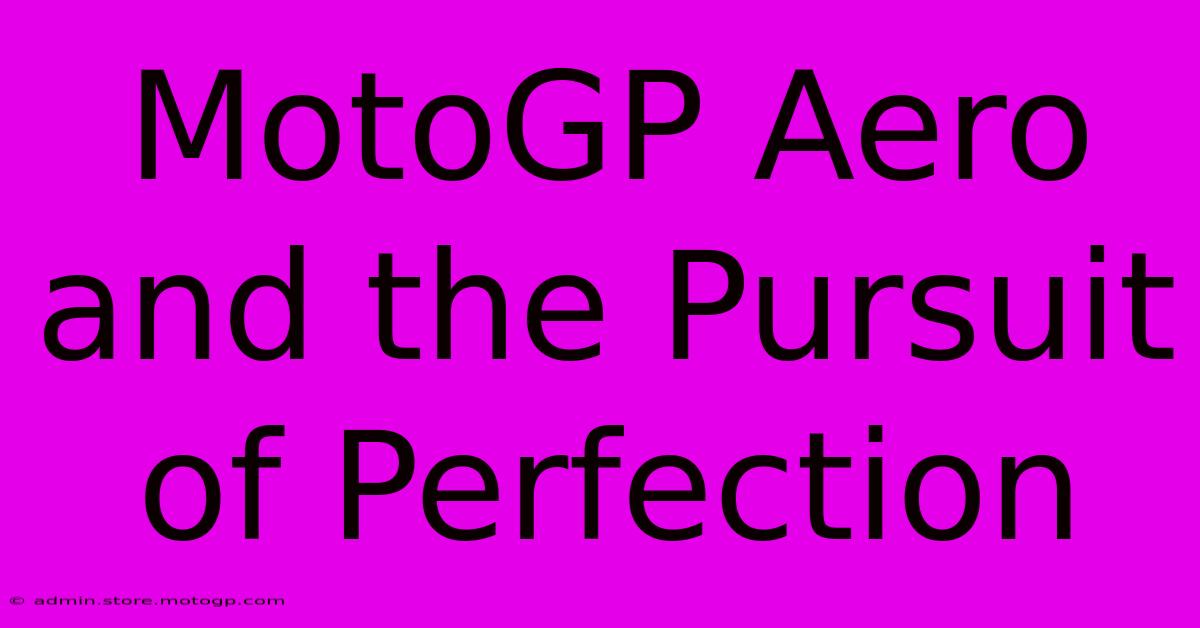MotoGP Aero And The Pursuit Of Perfection

Table of Contents
MotoGP Aero and the Pursuit of Perfection
The roar of the engines, the breathtaking speeds, the nail-biting finishes – MotoGP is a spectacle of skill and technology. But beyond the raw power and rider talent lies a crucial element often overlooked: aerodynamics. The pursuit of aerodynamic perfection is a relentless arms race in MotoGP, a constant battle to shave milliseconds off lap times and gain a crucial competitive edge. This article delves into the fascinating world of MotoGP aero, exploring its complexities and its crucial role in determining race outcomes.
Understanding the Importance of Aerodynamics in MotoGP
MotoGP bikes travel at incredibly high speeds, generating substantial downforce at those speeds. This downforce is crucial for several reasons:
-
Stability: At speeds exceeding 200 mph, stability is paramount. Aerodynamic components generate downforce, pressing the bike firmly to the track, enhancing grip and reducing the risk of high-speed wobbles or crashes. This is especially critical during cornering, where centrifugal forces are at their highest.
-
Braking Performance: Increased downforce translates to improved braking performance. The extra grip allows riders to brake later and harder into corners, shaving precious seconds off their lap times. This seemingly small advantage can be the difference between victory and defeat.
-
Cornering Speed: Improved stability and braking allow riders to carry more speed through corners. This is where the real time gains are made, as maintaining higher speeds throughout the lap adds up significantly over the course of a race.
-
Rider Comfort and Control: While less obvious, aerodynamics also contributes to rider comfort and control. Efficient aero designs reduce buffeting and turbulence, allowing riders to maintain better focus and exert less physical effort, particularly crucial during grueling races.
The Evolution of MotoGP Aerodynamics
The evolution of MotoGP aerodynamics has been dramatic. Early bikes were relatively simple, relying primarily on fairings to manage airflow. However, modern MotoGP machines are equipped with sophisticated aerodynamic devices, including:
-
Winglets: These small, wing-like appendages are strategically positioned to generate downforce, particularly at the front of the bike. Their design and placement are crucial, as poorly designed winglets can create drag and hinder performance.
-
Aerodynamic Fairings: The fairings themselves are meticulously designed to optimize airflow around the bike, minimizing drag and maximizing downforce. Computational fluid dynamics (CFD) plays a significant role in the design and testing process.
-
Bodywork: The entire bodywork of a MotoGP bike is carefully sculpted to enhance aerodynamic efficiency. Every curve and angle is designed to manage airflow, directing it to generate downforce while reducing drag.
-
Underbody Aerodynamics: Designers are increasingly focusing on underbody aerodynamics, utilizing strategically placed components to manipulate airflow beneath the bike and enhance downforce.
The Constant Battle for Aerodynamic Advantage
The quest for aerodynamic perfection is an ongoing process. Teams constantly experiment with new designs, materials, and configurations, seeking even the slightest performance improvement. This involves:
-
Wind Tunnel Testing: Extensive wind tunnel testing is essential to evaluate and refine aerodynamic designs. Teams use sophisticated wind tunnels to simulate race conditions and measure the performance of different components.
-
Computational Fluid Dynamics (CFD): CFD simulations are used to model airflow around the bike, allowing engineers to test and optimize designs virtually before building and testing physical prototypes.
-
Data Analysis: During races, teams collect vast amounts of data on bike performance, including aerodynamic data. This data is used to further refine designs and optimize setup.
The Future of MotoGP Aerodynamics
The future of MotoGP aerodynamics will likely involve even more sophisticated designs and technologies. We can expect to see:
-
Active Aerodynamics: This involves incorporating adjustable aerodynamic components that can adapt to different track conditions and speeds.
-
Further Integration of CFD and AI: The use of CFD and AI will become even more integral in the design and testing process, allowing for quicker iterations and more precise optimization.
-
Sustainable Materials: There's increasing focus on using lighter and more sustainable materials in the construction of aerodynamic components.
The pursuit of perfection in MotoGP aerodynamics is a testament to human ingenuity and the relentless drive for innovation. It's a continuous process of development and refinement, shaping the future of motorcycle racing and delivering ever more thrilling spectacles for fans worldwide. The battle for aerodynamic supremacy is as crucial as the skills of the riders themselves, highlighting the critical interplay between technology and talent in this exhilarating sport.

Thank you for visiting our website wich cover about MotoGP Aero And The Pursuit Of Perfection. We hope the information provided has been useful to you. Feel free to contact us if you have any questions or need further assistance. See you next time and dont miss to bookmark.
Featured Posts
-
Formula 1 Parking Your Guide To The Best Parking Spots
Feb 20, 2025
-
Moto Gp Sprint Gear Up For Non Stop Action
Feb 20, 2025
-
Sprint Race Austin Get Your Tickets Now
Feb 20, 2025
-
How Many Horses Power A Moto Gp Bike The Answer Revealed
Feb 20, 2025
-
Moto Gp Starting Grid A Guide For New Fans
Feb 20, 2025
